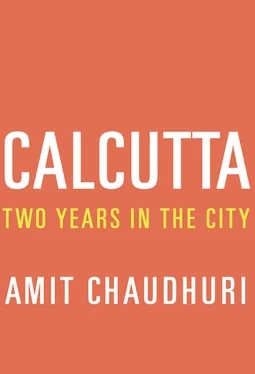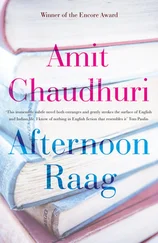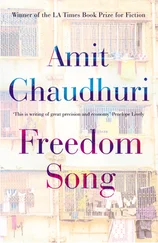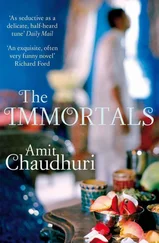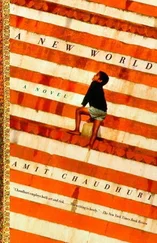Samirda’s drawing room has lovely wooden floorboards; but the teas have moved to the bedroom, so that he doesn’t have to take the trouble to emerge. We find him on his bed (a high hospital bed it is), seated and leaning backward, still proffering his hand oddly, and with that disarming gentility; part yogi in his posture (he has, in fact, started doing one of Baba Ramdev’s breathing exercises to keep his nasal passages clear), and part public schoolboy, as his feet are always in socks, whatever the weather, to protect him from the threat of a cold. Besides, as Tagore once pointed out, no person of Ingabanga descent would be caught in human society without their socks on. The Mukherjees, you feel, live at last in the present — a shrinking of space and time into this apartment which has almost accidentally, but properly, become their home. And the present is always built upon the decimation of the past, its erasure, the drawing room with the new floorboards acquired only once the skeleton of the past has been taken out and laid to rest.
Italian food was not always a worldwide phenomenon. Pizzas may feel timeless, of course; it’s hard to recall when they didn’t exist. Even when they were physically absent in India (in the early seventies), you encountered them time and again in comic books. An insouciant boy named Jughead, eyes shut, was repeatedly interring the long triangle into his open mouth. It would have been impossible to guess then that in two decades the pizza — no toppings, just a lot of tomato purée smeared on a cardboard-flat circle of bread, covered by a supplement of cheese — would become an indispensable component in the diet of gregarious Gujarati and North Indian families (people without pretensions, but with an appetite), and even turn up not far away from uttapam and rava dosa on South Indian menus.
In the seventies, I remember from my visits to London, Italian restaurants did very modest business. Italian waiters in spotless white clothes were always seated in an abstracted way within, waiting, without a great deal of conviction, the customer’s arrival. When they did arrive, the waiter showed no great excitement, but an ironical air of vindication that some people had nothing better to do than eat at Italian restaurants. For the London customer, Italian restaurants were then principally famous — in an unarticulated way — for their red and white chequered tablecloths. Their unmistakable pattern, imprinted on the mind’s eye, suggested the secluded world of Italian gastronomy. A strict and limited gastronomy it was: minestrone soup, comprising a lot of diced carrots, potatoes, and celery swilling about in reddish tomato-shot water (the tomato is the Italian chef’s default condiment, something to reach for absently before any thoughts or recipes have germinated in his head); spaghetti bolognese, as well known as Pompeii and the leaning tower of Pisa; spaghetti napolitana, where the chef had little more to do than empty a muck of tomato purée on a bed of worm-like pasta; spaghetti and meatballs, really more of a comic diversion for children or a prop on film sets than a real dish; and the layered and steaming lasagne, with its bright red tomato borders and its exorbitance of cheese. In that lonely world, visited once in three years, this was plenitude. In those days it didn’t matter that business was scarce; like a flag from a different country, restaurants could survive emblematically and indefinitely on foreign soil.
Spaghetti was, by silent consensus, the one respected pasta. Sometimes its blunt, midget-like, pug-nosed cousin macaroni would make an appearance in colleges and hospitals, even in India: food to amuse the convalescent. It was not just the increased activity of the European Union (morphed anew from the European Community) but the fall of the Berlin Wall and the rush of globalisation that would release into the world the bewildering variations on spaghetti — the flat, tapeworm-like tagliatelle; the slim linguini and anorexically slight tagliarini; spinach pasta and wholemeal pasta — as crazy and multiracially colourful as the Carnaby Street hairstyles of the sixties; and something called “fresh pasta” in English supermarkets, bunched-up, fluffy bundles.
This cataclysm approached India in a manner of speaking, without any seriousness of detail. All foreign food is doomed to be consumed in India not so much by Indians as by a voracious Indian sensibility, which demands infinite versions of Indian food, and is unmoved by difference. However, come Italian food did, given momentum by its new world-conquering pedigree. And it first nudged Calcutta in its new avatar in 2003, in the form of an Italian chef, Alex Bignotti, who looked about sixteen years old, and who, one day, appeared in the Taj Bengal hotel in order to bring real Italian flavours to the menu. A frail, small, and perky young man, he did this successfully, introducing cappuccino of wild mushroom and cherry tomato bisque to the coffee shop. A few years after moving to Calcutta myself, I tasted this cappuccino and thought it was unusual: I asked to see the chef to check out his features and demeanour personally, and to compliment him. This was when Bignotti was brought to our table, like a tentative and slightly suspicious schoolboy. I was taken aback — not just by his pale youthfulness, his air of being an underage Gujarati bridegroom lost at his wedding, but the fact that he was here at all. He must have been Calcutta’s first skilled import in decades — at least from Europe. Although his name was blazoned on the new menu booklet, I don’t know if anyone properly registered his presence. Anyway, there would be a feeling, mordant and inevitable, and one that often attends visiting chefs in the city, that Bignotti’s presence in Calcutta meant that he couldn’t be good enough. Of course, his culinary skills belied this local prejudice. He’d come from Milan — actually, from a town a few miles outside it. Given his unassuming boyish looks, you thought of him less as a global chef than as someone you might glimpse on an afternoon, cycling up that town’s narrow alleys. Then, one day, just as we were beginning, patronisingly, to take him for granted, he had gone — to Bombay, we later heard, the latest stop on his mysterious journey outward from that Milanese suburb.
Not long ago, I met the head chef of the Taj Bengal, Mr. Sujan Mukherjee. We sat in the Hub, the very place that had been reinvented in the early 2000s from a previous incarnation of the coffee shop, the Esplanade, and among whose first smart initiatives was the acquisition of Bignotti. Mr. Mukherjee had heard of Bignotti, but narrowly missed running into him. He himself reached Taj Bengal from Delhi in 2005.
At this time, he says, the Taj appointed Bignotti’s successor — Anteleno Medda.
“Can you spell that?” I ask him, my pen raised.
However, Googling him, I find no trace of him — unlike Alex Bignotti, who readily springs up on a couple of sites. He seems to have aged, and departed his late teens. He’s also left behind a favourable impression before moving on to wherever he is now (chefs are like the double agents of yore, playing on all sides of the international divide); I say “left behind” because among the results comes up a plaintive message: “Where is Alex Bignotti? I used to know him in Mumbai …”
There’s no denying that Anteleno Medda, or whatever his name was, did exist — because I saw him myself at the Hub, a short, stocky man in a chef’s pristine white uniform, moving about the tables with an easy familiarity, stopping to chat with a bunch of foreigners (foreigners to us Indians; they may, of course, have been his countrymen). I thought, Now who is this? intrigued by the European men in chef’s attire filing into this city.
Читать дальше
